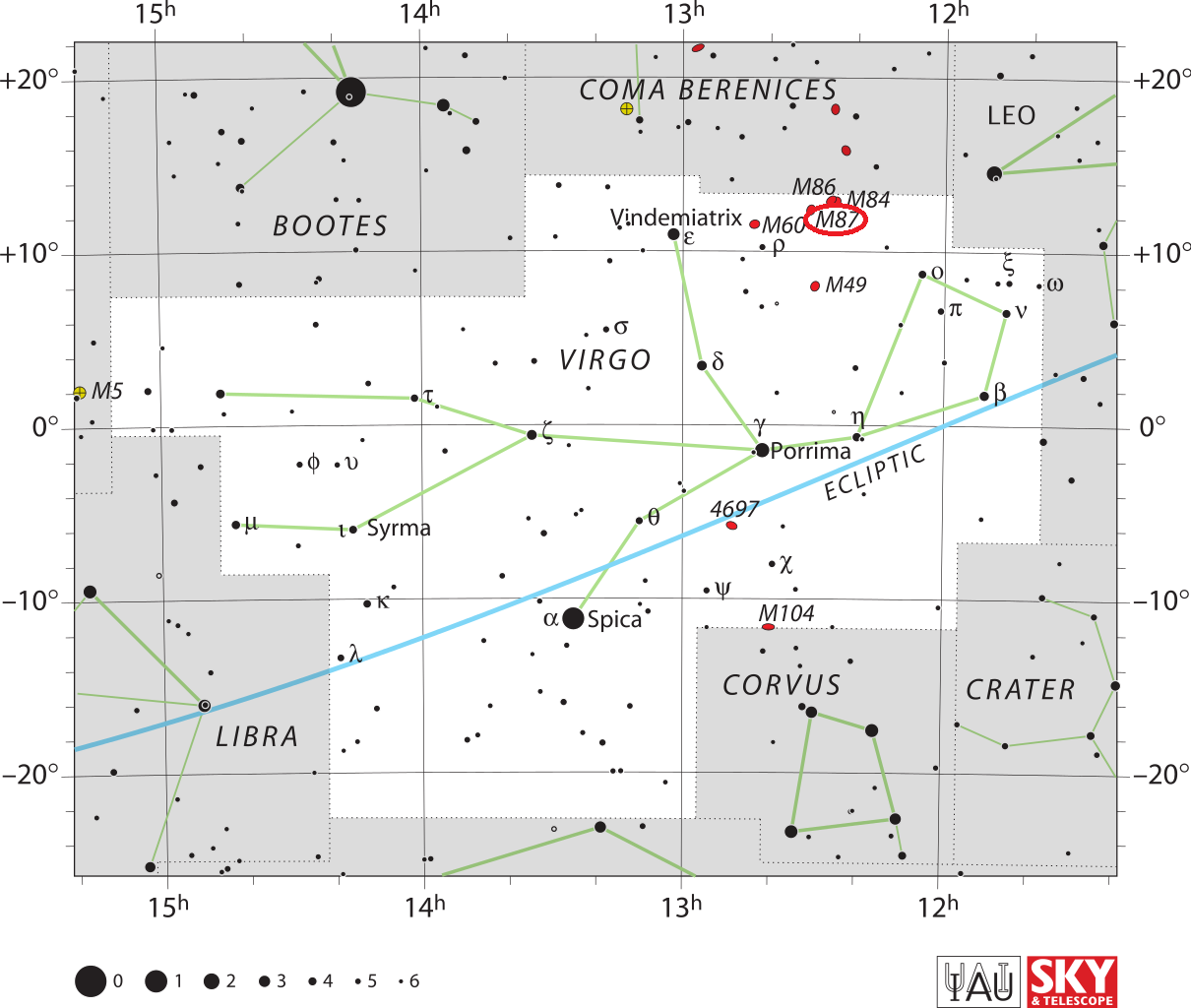Messier 87 (M87), also known as Virgo A or the Smoking Gun, is a supergiant elliptical galaxy located in the core of the Virgo Cluster, in the southern constellation Virgo. The galaxy has an apparent magnitude of 9.59 and lies at a distance of 53.5 million light years from Earth. It has the designation NGC 4486 in the New General Catalogue.
Virgo A occupies an area of 7.2 by 6.8 arc minutes of apparent sky, which corresponds to a linear diameter of 120,000 light years, roughly the same size as the Milky Way. It is the second brightest galaxy in the northern part of the Virgo Cluster, second only to Messier 49.
M87 can be observed in small and medium-sized telescopes. These reveal the galaxy’s core, which is about 45 arc seconds in apparent size. The jet emanating from the nucleus of M87 is difficult to see without photographic equipment.
In 10×50 binoculars, M87 appears only as a faint patch of light. Small telescopes show a fuzzy ball of light, elliptical in shape, with a slightly brighter centre. Being an elliptical galaxy, Virgo A appears mostly featureless even when seen in larger telescopes.
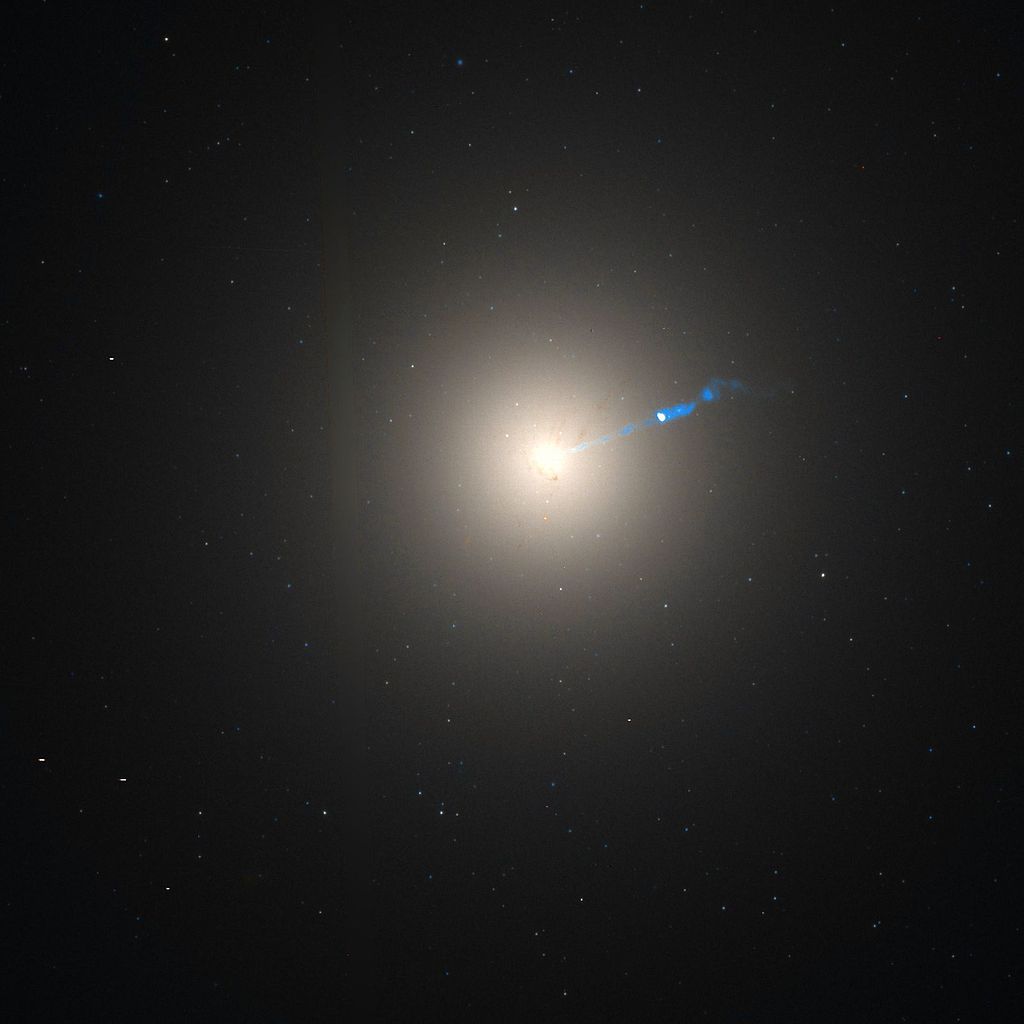
Messier 87 is positioned near the border with the constellation Coma Berenices and can be found just over halfway along the line from the bright star Denebola in Leo to Vindemiatrix in Virgo. Another elliptical galaxy, Messier 89, lies just over a degree to the east, while Messier 84 and Messier 86 are about 1.5 degrees to the northwest of M87. Virgo A can also be located using the M84/M86 pair, positioned almost exactly halfway between Denebola and Vindemiatrix. Two fainter ellipticals, NGC 4476 and NGC 4378, can be seen in the same low power field of view as M87. Other galaxies in the vicinity include NGC 4478, NGC 4486A and NGC 4486B. The best time of year to observe M87 and other galaxies in the Virgo Cluster is during the spring.
Messier 87 is one of the largest, most massive and most luminous galaxies in the local universe. It has an estimated mass of almost 2.7 trillion solar masses and an absolute magnitude of about -22. The galaxy is home to at least 1 trillion stars. The stars form only a fraction of the galaxy’s mass. M87 has an estimated mass to luminosity ratio of 6.3, which means that about one sixth of M87’s mass is in the form of stars. The total mass of the galaxy may be 200 times that of the Milky Way, even if the galaxies are similar in size.
Giant elliptical galaxies commonly form after a series of mergers of large spiral galaxies like the Milky Way. Elliptical galaxies outnumber other types in the central region of the Virgo Cluster and, as the cluster members move toward the cluster’s core and merge, M87 will only grow larger.
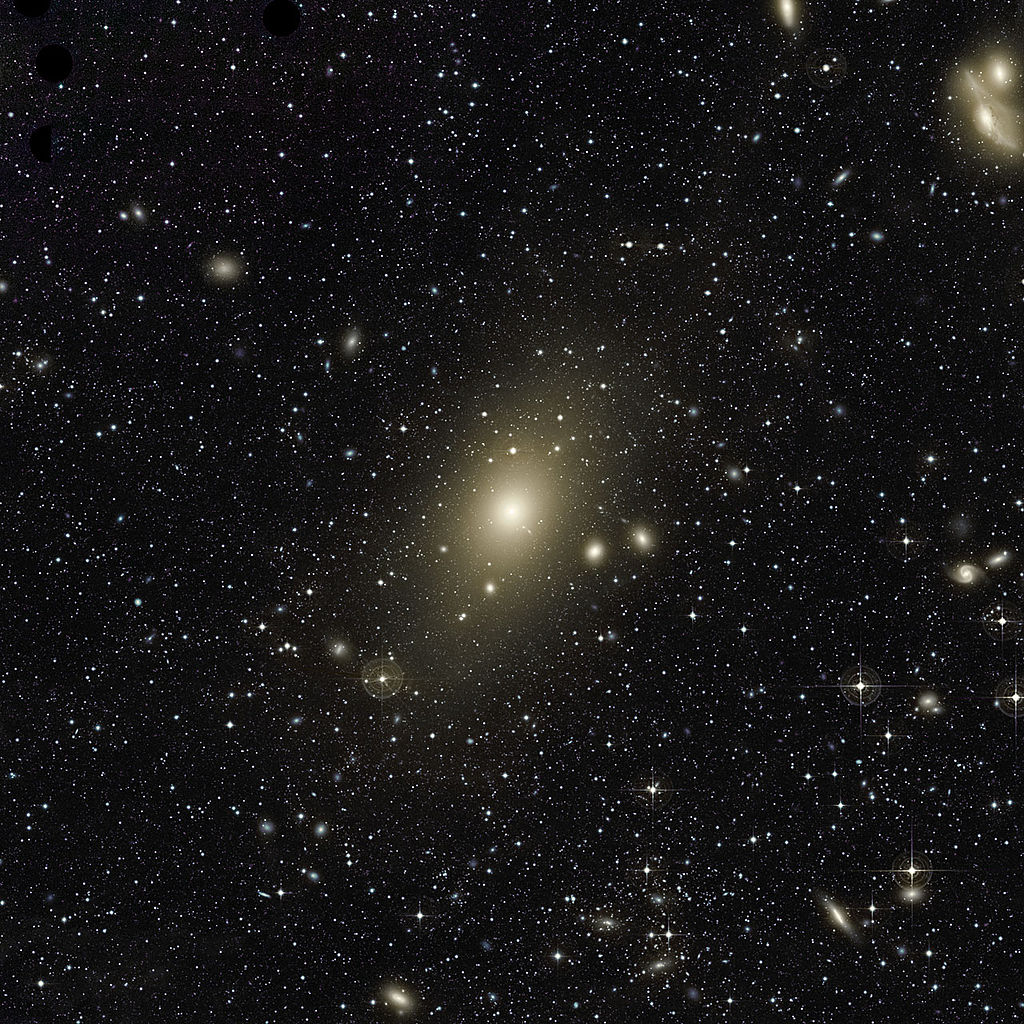
Currently, M87 is still dwarfed by IC 1101, a supergiant elliptical galaxy at the centre of the Abell 2029 cluster and the brightest galaxy in the group. IC 1101 is the largest galaxy in the known universe. Also located in the constellation Virgo, it is almost three times the size of M87 and home to about four times as many stars. However, IC 1101 is more than a billion light years from Earth, or 20 times farther away than M87.
Deep long exposure photographs have revealed that Virgo A extends far beyond 120,000 light years, showing that the galaxy’s outer regions are quite elongated rather than circular and occupy an area of over half a degree, more than the full Moon. This apparent size corresponds to a spatial extension of over 1 million light years. The outer regions of M87 are considerably distorted, likely as a result of encounters with other galaxies in the intracluster neighbourhood, with the giant M87 absorbing material from the smaller cluster members into these regions.
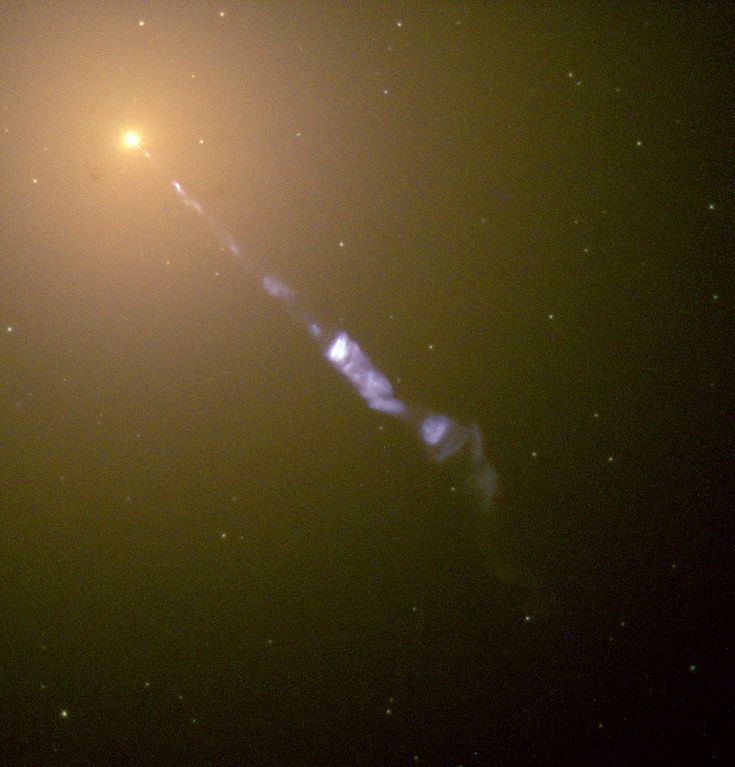
The galaxy has a jet of energetic plasma emanating from its core and extending at least 4,900 light years outwards. The jet consists of gaseous material expelled from the galaxy’s nucleus and travels at relativistic speed. Observations with the Hubble Space Telescope in 1999 revealed that the jet was moving at four to six times the speed of light. The gas clouds have an apparent superluminal motion, which is likely an illusion caused by the fact that the jet is pointing in our direction. The discovery of such motion supports the theory that quasars, radio galaxies and BL Lacertae objects may all in fact be active galaxies, only seen from different perspectives.
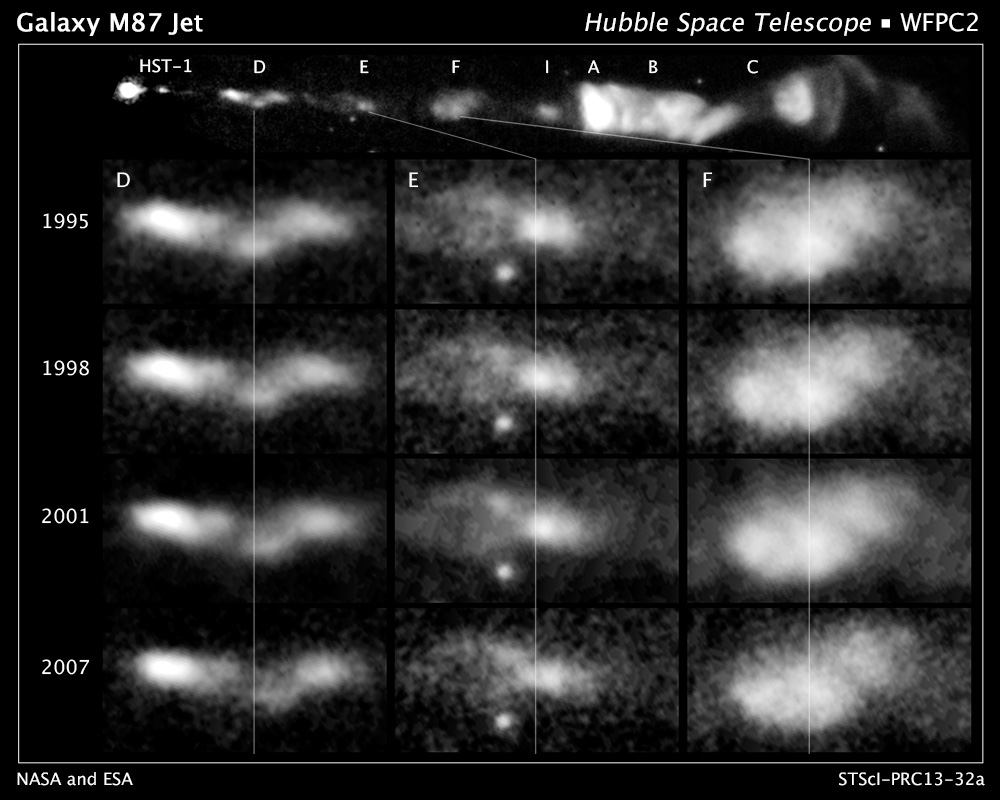
The observations show that the river of plasma, travelling at nearly the speed of light, may follow the spiral structure of the black hole’s magnetic field, which astronomers think is coiled like a helix. The magnetic field is believed to arise from a spinning accretion disc of material around a black hole. Although the magnetic field cannot be seen, its presence is inferred by the confinement of the jet along a narrow cone emanating from the black hole. The visible portion of the jet extends for some 5000 light-years. M87 resides at the centre of the neighbouring Virgo cluster of roughly 2000 galaxies, located 50 million light-years away.
The images are part of a time-lapse movie that reveals changes in the jet from 1995 to 2007. They were taken by Hubble’s Advanced Camera for Surveys in 2006 and the Wide Field Planetary Camera 2 in 1995, 1998, 2001, and 2007. Image: NASA, ESA, E. Meyer, W. Sparks, J. Biretta, J. Anderson, S.T. Sohn, and R. van der Marel (STScI), C. Norman (Johns Hopkins University), and M. Nakamura (Academia Sinica)
The only person who was able to see the jet visually, without the aid of photography, before 1991, was the Ukrainian-American astronomer Otto Struve, who used the 100-inch Hooker telescope at the Mount Wilson Observatory in Los Angeles to observe the galaxy. Today, the jet can be seen in large amateur telescopes under exceptionally clear and dark skies.
The giant jet was first detected by the American astronomer Heber Curtis of the Lick Observatory in California in 1918. Curtis also noted that M87 does not have a spiral structure.
In 1966, American astronomer Halton Arp discovered a second jet pointing in the opposite direction, and included M87 in his Atlas of Peculiar Galaxies as Arp 152.
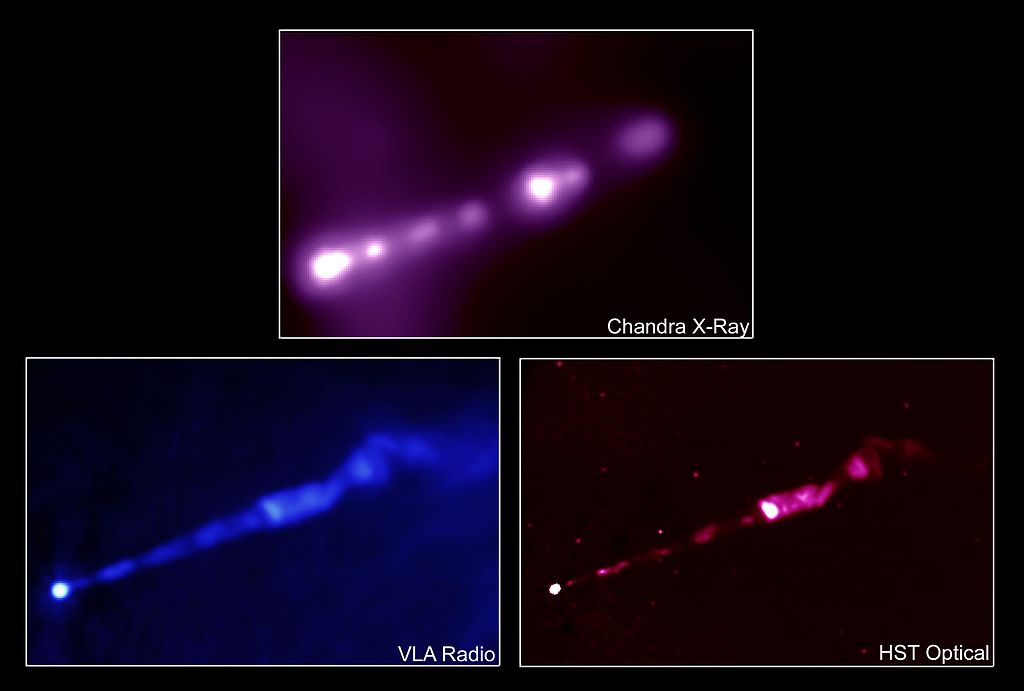
Radio: F. Zhou, F. Owen (NRAO), J. Biretta (STScI)
Optical: E. Perlman (UMBC), et al., STScI, NASA
The Virgo Cluster is divided into at least three subgroups centred on the galaxies M87, M49 and M86. The subsystem centred around M87 is known as Virgo A and the one associated with M49 as Virgo B. The region around M87 is heavily populated by elliptical and S0-type galaxies and there is a chain of ellipticals aligned with M87’s jet.
Messier 86 and Messier 87 are believed to be moving toward each other and heading for their first encounter. M87 may have interacted with M84 in the past, which would explain M87’s truncated halo. However, the truncation may also be a result of contraction caused by unseen mass falling into the galaxy from the rest of the cluster. The unseen mass may be the hypothesized dark matter. Another possible cause of the truncation may be early feedback from M87’s active galactic nucleus, which may have affected the halo formation.
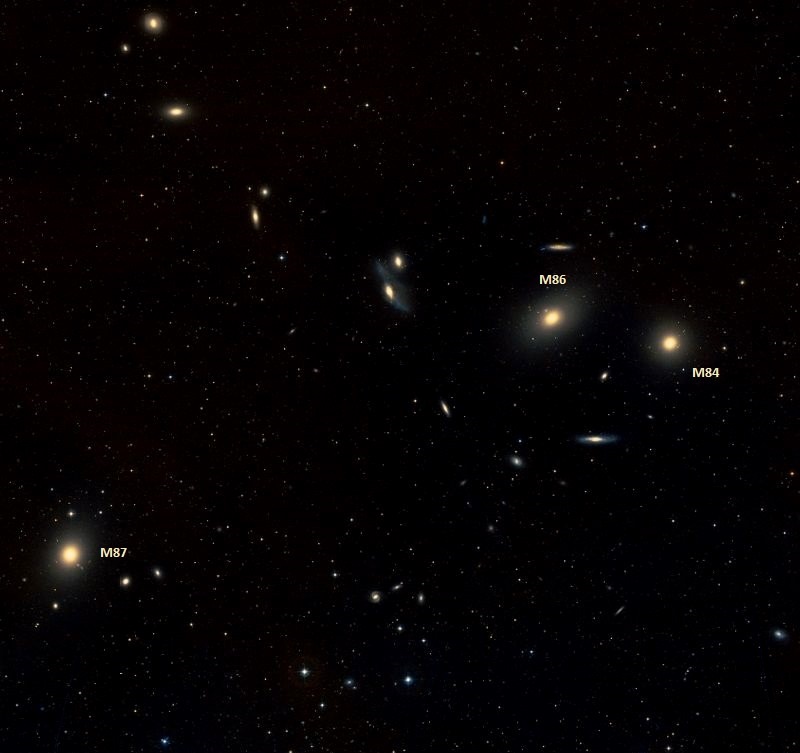
The stars in Virgo A have a spherically symmetric distribution and the most densely populated regions are those closest to the galaxy’s core. The density decreases with increasing distance from the centre.
Virgo A contains a supermassive black hole with an estimated mass of 6.5 billion solar masses, one of the most massive black holes known. The object, positioned within the central 60 light years of the galaxy’s core, is orbited by a disk of ionized gas which is rotating at velocities of up to 1,000 km/s. The disk has a diameter of up to 0.39 light years (0.12 parsecs) and is oriented perpendicular to the relativistic jet emerging from M87’s nucleus.
The central supermassive black hole is a strong source of radiation in multiple wavelengths, especially radio waves. It is the main component of M87’s active galactic nucleus, which is sometimes known as the Smoking Gun. Observations have indicated that the black hole may be offset from the galaxy’s centre by about 25 parsecs in the direction opposite to the jet. This may suggest that the jet accelerated the black hole away from the galaxy’s centre or that the black hole was displaced as a result of a merger with another galaxy.
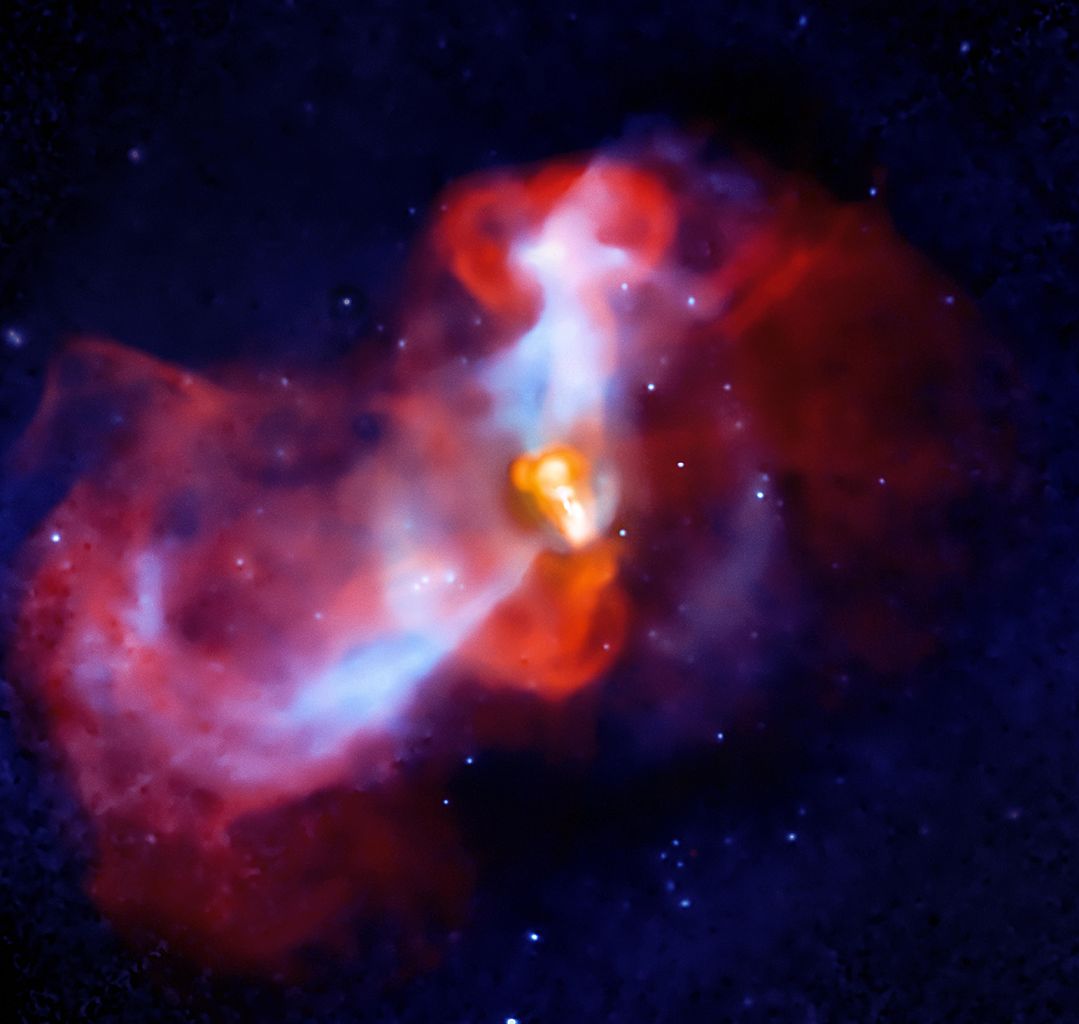
Messier 87 has an enormous population of globular clusters, with an estimated number of 12,000 globulars, revealed in a survey conducted in 2006. For comparison, the Milky Way contains about 150 to 200 globulars.
The first ever hypervelocity globular cluster was detected in M87. Named HVGC-1, the cluster was discovered escaping the galaxy. The discovery indicates that the galaxy has not one but two central supermassive black holes as a result of a collision with another galaxy in the distant past.
Almost a hundred ultra-compact dwarfs have been identified in M87. Ultra-compact dwarfs are similar to globular clusters, but have a diameter of 33 light years or more. It is unclear whether they are a new class of globulars or dwarf galaxies absorbed by M87.
Messier 87 is one of the brightest known radio sources in the sky. A strong radio source coinciding with the position of M87 was detected in 1947 and labelled Virgo A. The source was identified as M87 by 1953, with the relativistic jet emanating from the galaxy’s core suggested as a likely cause.
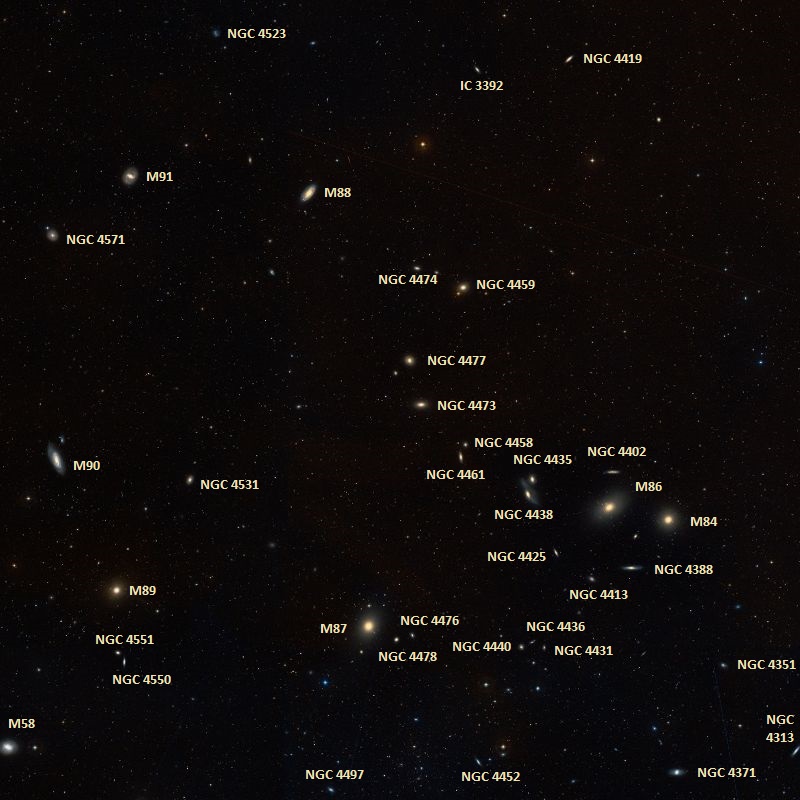
Messier 87 is also a strong source of X-ray emissions. It is positioned near the centre of a hot, X-ray emitting cloud that extends far over the Virgo Cluster. The X-ray emissions have destroyed most of the interstellar dust, leaving only about 70,000 solar masses of dusty material in M87, which is less than that found in the Milky Way, which contains about 108 million solar masses of dust.
Virgo X-1, the first extragalactic X-ray source, was detected in April 1965. It was the first source of radio emission discovered in the constellation Virgo.
Messier 87 is also a very strong source of gamma rays, which have been observed in the galaxy since the late 1990s. Observations with the HESS Cherenkov telescopes in 2006 revealed that the gamma ray flux changes over a matter of days. The short period variations make the region immediately surrounding the central supermassive black hole the most likely candidate for the gamma ray source.
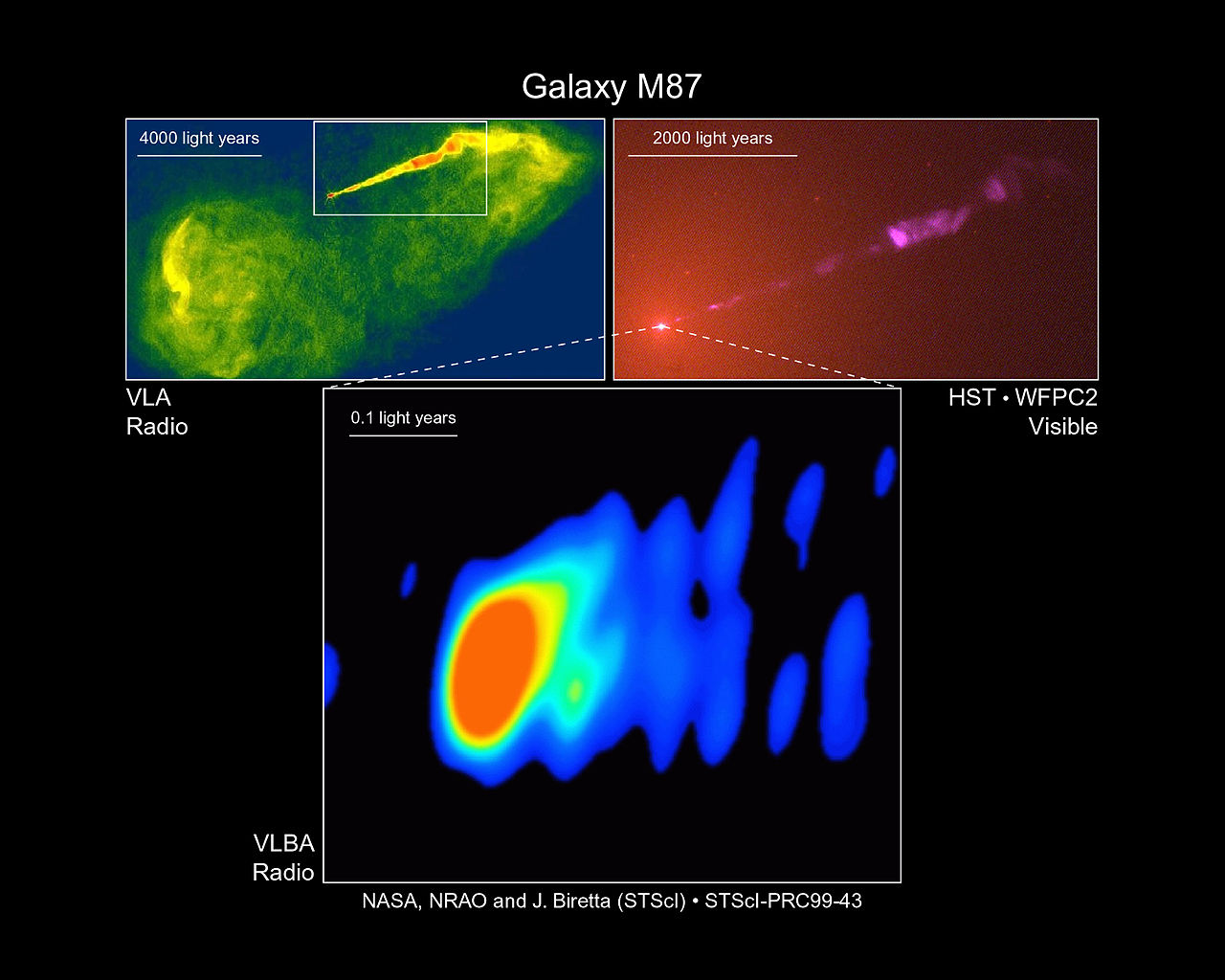
[top right] – A visible light image of the giant elliptical galaxy M87, taken with NASA Hubble Space Telescope’s Wide Field Planetary Camera 2 in February 1998, reveals a brilliant jet of high-speed electrons emitted from the nucleus (diagonal line across image). The jet is produced by a 3-billion-solar-mass black hole.
[bottom] – A Very Long Baseline Array (VLBA) radio image of the region close to the black hole, where an extragalactic jet is formed into a narrow beam by magnetic fields. The false color corresponds to the intensity of the radio energy being emitted by the jet. The red region is about 1/10 light-year across. The image was taken in March 1999.
Credit: NASA, National Radio Astronomy Observatory/National Science Foundation, John Biretta (STScI/JHU), and Associated Universities, Inc.
Edwin Hubble categorized M87 as an elliptical extra-galactic nebula with no apparent elongation in 1926. At the time, M87 was the only elliptical nebula with resolvable stars. By 1931, Hubble identified it as a member of the Virgo Cluster. M87 was not identified as an E0-type galaxy until 1956. The classification was later modified to E0p, with the ‘p’ suffix indicating a peculiar galaxy, referring to its jet.
Virgo A is also classified as a type-cD galaxy, a supergiant D class galaxy, one with an elliptical-like nucleus and an extensive dustless envelope.
In June 2015, observations with the FLAMES spectrograph on ESO’s Very Large Telescope revealed that M87 has absorbed an entire medium-sized galaxy in the last billion years. Astronomers tracked the motions of 300 planetary nebulae and found evidence of both the merger and of excess light coming from the remains of the smaller galaxy. Some of the nebulae in M87’s enormous halo were discovered to be moving toward us while others were receding. A large portion of M87’s outer halo now appears twice as bright as it would if the merger had not occurred and the stars absorbed from the smaller galaxy are scattered over a region about 100 times larger than the entire absorbed galaxy was. The galaxy is believed to have been a star forming spiral because the collision added some younger, bluer stars to M87.
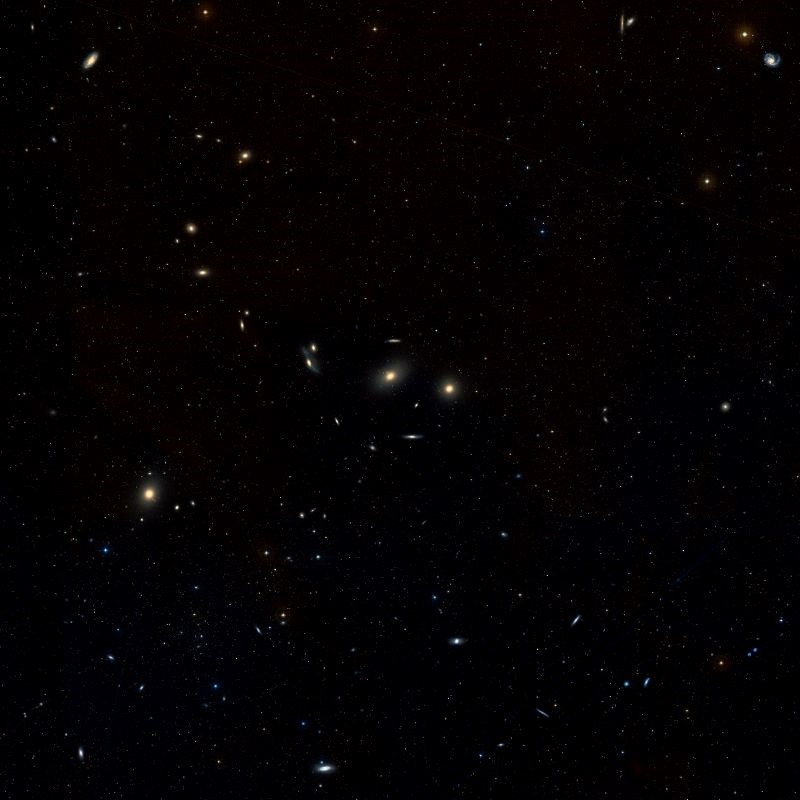
Virgo A was discovered by Charles Messier on March 18, 1781, along with seven other members of the Virgo Cluster – M84, M85, M86, M88, M89, M90 and M91 – and the globular cluster M92, located in the constellation Hercules. Messier noted:
Nebula without star, in Virgo, below & very near a star of eighth magnitude, the star having the same Right Ascension as the nebula, & its Declination was 13d 42′ 21″ north. This nebula appears at the same luminosity as the two nebulae Nos. 84 and 86.
John Herschel catalogued M87 as h 1301 and later added it to the General Catalogue as GC 3035. He described the object as “very bright; very large; round; much brighter toward the middle.”
Heber Curtis photographed M87 with the Crossley Reflector at the Lick Observatory and offered the following description:
NGC 4486, RA=12:25.8, Dec=+12:57. Exceedingly bright; the sharp nucleus shows well in 5m exposure. The brighter central portion is about 0.5′ in diameter, and the total diameter is about 2′; nearly round. No spiral structure is discernible. A curious straight ray lies in a gap in the nebulosity in p.a. 20deg, apparently connected with the nucleus by a thin line of matter. The ray is brightest at its inner end, which is 11″ from the nucleus. 20 s.n.
FACTS
| Object: Galaxy |
| Type: Elliptical |
| Class: E+0-1 pec, NLRG Sy |
| Designations: Messier 87, M87, NGC 4486, Virgo A, Smoking Gun, Virgo X-1, PGC 41361, UGC 7654, Arp 152, VCC 1316, 3C 274, 3U 1228+12, 1A 1228+12, GIN 800, H 1227+12, CTA 54, DA 325, DB 85, 2E 2744, 2E 1228.2+1240, GALEX J123049.4+122328, IRAS 12282+1240, 2MASX J12304942+1223279, MCG+02-32-105, MRC 1228+126, NRAO 401, NRL 8, PKS 1228+12, VPC 771 |
| Features: Enormous relativistic jet |
| Constellation: Virgo |
| Right ascension: 12h 30m 49.42338s |
| Declination: +12°23’28.0439” |
| Distance: 53.5 million light years (16.40 megaparsecs) |
| Number of stars: 1 trillion |
| Apparent magnitude: +9.59 |
| Absolute magnitude: -22 |
| Apparent dimensions: 7′.2 x 6′.8 |
| Radius: 60,000 light years |
| Redshift: 0.004360 |
| Heliocentric radial velocity: 1,307 km/s |
| Galactocentric velocity: 1,254 km/s |
LOCATION
